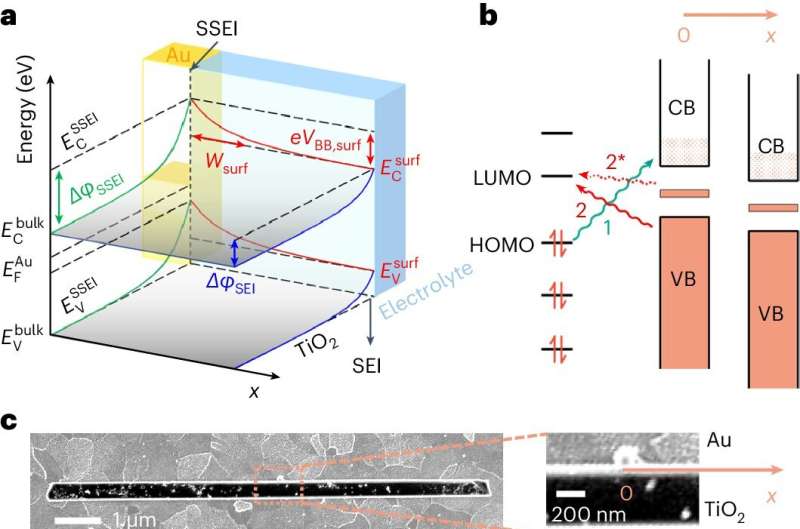This article has been reviewed according to Science X's editorial process and policies. Editors have highlighted the following attributes while ensuring the content's credibility:
fact-checked
peer-reviewed publication
trusted source
proofread
Gold co-catalyst improves photocatalytic degradation of micropollutants, finds study

To remove micropollutants such as pesticides and trace chemicals from the environment, you need something equally small and cunning. One potential method is photocatalysis, which uses semiconducting nanomaterials powered by sunlight to adsorb toxic chemicals on the materials' surface and degrade them.
A Cornell team has used a new form of high-resolution optical imaging to better understand how adsorption—i.e., the clinging of molecules to surfaces—works on the semiconductor titanium dioxide (TiO2) with a gold particle added as a co-catalyst.
They found the gold enhances the adsorption across a surprisingly large area of the semiconductor's surface—more than a micrometer away from the source. The discovery could increase the efficiency of photocatalysis for eliminating micropollutants in wastewater.
The findings were published July 19 in Nature Catalysis. The paper's lead author is former Cornell postdoctoral researcher Ming Zhao, now of the National University of Singapore. The project was led by Peng Chen, the Peter J.W. Debye Professor of Chemistry in the College of Arts and Sciences, and the paper's senior author.
Enhancing titanium dioxide with gold is a fairly common form of photocatalysis, which is why Chen's team selected the combination. They wanted to work with well-established model systems. A pivotal development was the new imaging method: adCOMPEITS, short for Adsorption-based COMPetition Enabled Imaging Technique with Super-resolution, which builds off a previous process the lab devised.
In adCOMPEITS, a fluorescent probe molecule adsorbs onto a particle surface and its fluorescence is imaged. A nonfluorescent micropollutant molecule is then sent to bind to the surface, where it competes for adsorption with the fluorescent probe. The resulting decrease in probe adsorption—essentially creating a negative image—can then be measured and mapped with super high resolution.
The team used the method to quantify the adsorption of two representative micropollutants, the pesticide pirimiphos methyl and the plasticizer diethyl phthalate, under a variety of reaction and nonreaction conditions.
"We measured the adsorption on the surface of this TiO2 nanorod at different locations and then particularly at the location where the gold particle is, and also at locations very far away from the gold particle," Chen said. "The gold nanoparticle is only 100 nanometers in size. We discovered it enhances adsorption microns away from where the particle is. That is like 10 times farther away."
The reason for that increased range is that the gold particle changes the electronic properties on the TiO2 surface, a phenomenon called surface band bending, which Chen's lab has previously studied in three-dimensional semiconductor particles that exhibit two-dimensional properties.
"It turned out the band bending not only bends the bands where it is, the band bending is along the surface of a TiO2," Chen said. "That band bending has an exponential decay profile that reaches microns away and gave rise to this long-range adsorption enhancement."
The discovery demonstrates a particular advantage of using metal nanoparticles such as gold as co-catalysts: Only a small amount is needed to enhance the adsorption on the semiconductor. This could ultimately help resolve one of the challenges of photocatalysis, which often has low conversion efficiency when turning solar energy into a chemical reaction. Beyond photocatalytic applications, it could also be used for processes such as sensing and dye-sensitized solar cells.
"This long-range enhancement should be broadly applicable," Chen said. "Extending this, one can think about enhancing many types of semiconductors using many types of co-catalysts with different electronic properties."
More information: Ming Zhao et al, Long-range enhancements of micropollutant adsorption on metal-promoted photocatalysts, Nature Catalysis (2024). DOI: 10.1038/s41929-024-01199-0
Journal information: Nature Catalysis
Provided by Cornell University



















